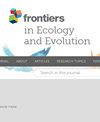亚马逊中部洪泛平原森林的水文和气候强化诱导了 Hydrochorea corymbosa 木质部生产的保守行为
IF 2.4
3区 环境科学与生态学
Q2 ECOLOGY
引用次数: 0
摘要
引言 洪水淹没森林中的树木必须调整木质部水力结构,以适应每年的洪水和大气的气候条件。通常,在热带地区,这种解剖组织的调整是由干旱事件引起的保守行为所驱动的,并可在树木年轮中记录下来。为了填补这一空白,我们探讨了洪水期和月度气候变化是否会影响亚马逊中部瓦尔泽亚洪泛森林中的树种 Hydrochorea corymbosa(豆科)的树木年生长和木质部解剖结构。我们建立了 41 年的年轮宽度年表(1971-2018 年)和 30 年的木质部解剖参数时间序列(1988-2018 年),包括平均水力血管直径(Dh)、血管频率(VF)和实质物质数量(PQ)。我们将这些时间序列与每月的水文和气候数据进行了关联。结果水文系统与该树种的树木年生长量并不像我们之前预期的那样相关,但却与木质部解剖结构相关。洪水末期的高洪水位诱导了解剖结构的保守模式,与 Dh 呈负相关(6 月 rho = -0.40,p < 0.05),与 PQ 呈正相关(9 月/10 月 rho = 0.42,p < 0.05)。这些反应表明,这些树木对洪水的反应与树木对干旱的反应类似。在气候变异方面,树木的年生长量与水汽压差(VPD)呈负相关,在洪水期的后半期之后,与非洪水期的相关性最强(12 月的 rho = -0.66,p < 0.01)。在这种情况下,我们认识到环境在两个不同的时刻诱导这些树木木质部结构的保守模式:1)洪水水位上升;2)非洪水期的高蒸发需求。因此,水文系统的加剧以及非洪水期的严重干旱可能会对亚马逊中部洪泛平原的 H. corymbosa 造成危害。本文章由计算机程序翻译,如有差异,请以英文原文为准。
Hydrological and climate intensification induces conservative behavior in the Hydrochorea corymbosa xylem production in a Central Amazon floodplain forest
IntroductionTrees from flooded forests have to adjust their xylem hydraulic structure to face the annual flooding and the climatic conditions of the atmosphere. Usually, this adjustment of anatomical tissues in the tropics is driven by drought events inducing conservative behavior and can be recorded annually in tree rings. However, how the flood pulse and the climatic conditions influence the xylem hydraulic structure in floodplain trees is unknown.MethodsTo fill this gap, we explore if flooded periods and monthly climate variation affect the annual tree growth and xylem anatomy structure for the tree species Hydrochorea corymbosa (Fabaceae) from the várzea flooded forest in the Central Amazon. We developed a 41-year ring width chronology (1971–2018) and a 30-year time series of xylem anatomy parameters (1988–2018) as mean hydraulic vessel diameter (Dh), vessel frequency (VF), and parenchyma quantity (PQ). We correlated the series with monthly hydrological and climatic data.ResultsThe hydrological regime did not correlate with annual tree growth in that species as we previously expected but showed correlations with the xylem anatomical structure. High flood levels during the end of the flooding period induced conservative patterns of the anatomical structure, with a negative correlation with Dh (rho June = −0.40, p < 0.05) and a positive correlation with the PQ (rho September/October = 0.42, p < 0.05). These responses show that these trees are responding to flooding similar to the tree responses to drought. Regarding the climatic variation, the annual tree growth showed a negative correlation with the vapor pressure deficit (VPD), after the second half of the flooded period with the strongest correlation happening during the non-flooded period (rho December = −0.66, p < 0. 01). These conservative patterns in tree behavior also happened when the maximum temperature negatively affected the vessel diameter (rho September = −0.42, p < 0.05).DiscussionIn that case, we recognized two different moments that the environment is inducing conservative patterns in the xylem structure of those trees: 1) increasing the flood levels and 2) the high evaporative demand during the non-flooded period. In this way, the intensification of the hydrological regime, as well as the strong drought conditions during the non-flooded periods, can be a risk for H. corymbosa in the Central Amazonian floodplains.
求助全文
通过发布文献求助,成功后即可免费获取论文全文。
去求助
来源期刊

Frontiers in Ecology and Evolution
Environmental Science-Ecology
CiteScore
4.00
自引率
6.70%
发文量
1143
审稿时长
12 weeks
期刊介绍:
Frontiers in Ecology and Evolution publishes rigorously peer-reviewed research across fundamental and applied sciences, to provide ecological and evolutionary insights into our natural and anthropogenic world, and how it should best be managed. Field Chief Editor Mark A. Elgar at the University of Melbourne is supported by an outstanding Editorial Board of international researchers. This multidisciplinary open-access journal is at the forefront of disseminating and communicating scientific knowledge and impactful discoveries to researchers, academics and the public worldwide.
Eminent biologist and theist Theodosius Dobzhansky’s astute observation that “Nothing in biology makes sense except in the light of evolution” has arguably even broader relevance now than when it was first penned in The American Biology Teacher in 1973. One could similarly argue that not much in evolution makes sense without recourse to ecological concepts: understanding diversity — from microbial adaptations to species assemblages — requires insights from both ecological and evolutionary disciplines. Nowadays, technological developments from other fields allow us to address unprecedented ecological and evolutionary questions of astonishing detail, impressive breadth and compelling inference.
The specialty sections of Frontiers in Ecology and Evolution will publish, under a single platform, contemporary, rigorous research, reviews, opinions, and commentaries that cover the spectrum of ecological and evolutionary inquiry, both fundamental and applied. Articles are peer-reviewed according to the Frontiers review guidelines, which evaluate manuscripts on objective editorial criteria. Through this unique, Frontiers platform for open-access publishing and research networking, Frontiers in Ecology and Evolution aims to provide colleagues and the broader community with ecological and evolutionary insights into our natural and anthropogenic world, and how it might best be managed.
 求助内容:
求助内容: 应助结果提醒方式:
应助结果提醒方式:


